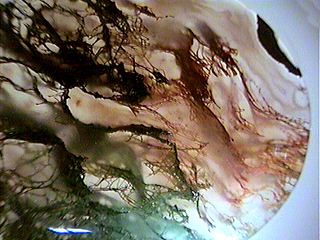Another type of pottery looking far more modern
than the period it was made. Pretty common on the Thames foreshore,
at least one piece being found on most mudlarking trips.
 |
| Mocha wear pottery shards found Mudlarking on the Thames |
It took me a while to find this pottery on the
internet and a while longer its name. It seems to be called ‘Mochaware’, a type
of dipped ware decorated with slip. The feature which sets it apart is clearly the fuzzy, blotting paper, sea weed like decorations. The technical name is ‘dentric’
(tree like or branching). They were thought to resemble the natural geological
markings on moss agate known as ‘Mocha Stone’ (pictured below), imported from Arabia
through the port of Mocha (al Mukha in Yemen) – hence the name. Apparently
geological patterns were rather popular in this period.
 |
| Moss Agate (from theimage.com) |
 |
| Mocha wear chamber pot (from artistheanswer) |
Clearly a new technique, it was achieved by dripping a coloured acidic solution into wet alkaline slip. The colour would instantly disperse into the random dentric markings. The bodies were creamware or pearlwear, later heavier and thicker whiteware bodies were used.
The main type of mochaware I’ve found has been the yellow bodies with blue dentric markings. I’ve read this is also called ‘yellow wear’. I’ve found a few other bits of mocha which I’ll cover in a future post, hoping to pick up a few more examples on my mudlarking wanderings.

Hello Julia'
ReplyDelete'Mocha' or banded ware as it's also known, was produced from around the middle of the C18th - early C20th and was probably most commonly used as the standard pint and quart mug in pubs and taverns across the country. You may be lucky enough to find a sherd with the government standard mark, indicating that the drinker is getting the amount of beer that he ordered!
happy hunting!
Michael